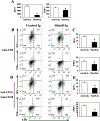Skint8, a Novel B7 Family-Related Molecule, Negatively Regulates T Cell Responses
- PMID: 31189570
- PMCID: PMC6615975
- DOI: 10.4049/jimmunol.1800639
Skint8, a Novel B7 Family-Related Molecule, Negatively Regulates T Cell Responses
Abstract
Immune responses are tightly controlled by T cell costimulatory and coinhibitory molecules. In this study, we identify Skint8 as a new member of the T cell coinhibitory group, whose extracellular domains share significant homology with existing B7 family members. Skint8 mRNA is expressed in resting and activated B cells, monocytes, and CD4 T cells. The Skint8 putative receptor is expressed on activated CD4 and CD8 T cells, B cells, monocytes and dendritic cells. Recombinant Skint8-IgG Fc fusion protein inhibits T cell proliferation, activation, and cytokine production in vitro. In vivo administration of Skint8-IgG Fc reduces T cell activation and alleviates experimental autoimmune encephalomyelitis in mice. The findings broaden our understanding of the regulation of immune responses and may have implications for treating immune-related diseases.
Copyright © 2019 by The American Association of Immunologists, Inc.
Conflict of interest statement
Figures





Similar articles
-
Murine B7-H3 is a negative regulator of T cells.J Immunol. 2004 Aug 15;173(4):2500-6. doi: 10.4049/jimmunol.173.4.2500. J Immunol. 2004. PMID: 15294965
-
VISTA, a novel mouse Ig superfamily ligand that negatively regulates T cell responses.J Exp Med. 2011 Mar 14;208(3):577-92. doi: 10.1084/jem.20100619. Epub 2011 Mar 7. J Exp Med. 2011. PMID: 21383057 Free PMC article.
-
ERMAP is a B7 family-related molecule that negatively regulates T cell and macrophage responses.Cell Mol Immunol. 2021 Aug;18(8):1920-1933. doi: 10.1038/s41423-020-0494-8. Epub 2020 Jul 3. Cell Mol Immunol. 2021. PMID: 32620788 Free PMC article.
-
Interferon-beta enhances monocyte and dendritic cell expression of B7-H1 (PD-L1), a strong inhibitor of autologous T-cell activation: relevance for the immune modulatory effect in multiple sclerosis.J Neuroimmunol. 2004 Oct;155(1-2):172-82. doi: 10.1016/j.jneuroim.2004.06.013. J Neuroimmunol. 2004. PMID: 15342209
-
Emerging concepts in autoimmune encephalomyelitis beyond the CD4/T(H)1 paradigm.Ann Anat. 2010 Aug 20;192(4):179-93. doi: 10.1016/j.aanat.2010.06.006. Epub 2010 Jul 15. Ann Anat. 2010. PMID: 20692821 Review.
Cited by
-
BTN2A2 protein negatively regulates T cells to ameliorate collagen-induced arthritis in mice.Sci Rep. 2021 Sep 29;11(1):19375. doi: 10.1038/s41598-021-98443-5. Sci Rep. 2021. PMID: 34588505 Free PMC article.
-
Recombinant CD300c-Ig fusion protein attenuates collagen-induced arthritis in mice.Rheumatology (Oxford). 2022 Mar 2;61(3):1255-1264. doi: 10.1093/rheumatology/keab450. Rheumatology (Oxford). 2022. PMID: 34021311 Free PMC article.
-
Immune checkpoint: The novel target for antitumor therapy.Genes Dis. 2019 Dec 20;8(1):25-37. doi: 10.1016/j.gendis.2019.12.004. eCollection 2021 Jan. Genes Dis. 2019. PMID: 33569511 Free PMC article. Review.
-
CHD7 regulates definitive endodermal and mesodermal development from human embryonic stem cells.Stem Cell Res Ther. 2025 Jun 17;16(1):311. doi: 10.1186/s13287-025-04437-9. Stem Cell Res Ther. 2025. PMID: 40528267 Free PMC article.
-
Administration of Recombinant TAPBPL Protein Ameliorates Collagen-Induced Arthritis in Mice.Int J Mol Sci. 2023 Sep 7;24(18):13772. doi: 10.3390/ijms241813772. Int J Mol Sci. 2023. PMID: 37762076 Free PMC article.
References
-
- Freeman GJ, Gribben JG, Boussiotis VA, Ng JW, Restivo VA Jr., Lombard LA, Gray GS, and Nadler LM 1993. Cloning of B7–2: a CTLA-4 counter-receptor that costimulates human T cell proliferation. Science (New York, N.Y.) 262: 909–911. - PubMed
-
- Dong H, Zhu G, Tamada K, and Chen L 1999. B7-H1, a third member of the B7 family, co-stimulates T-cell proliferation and interleukin-10 secretion. Nat. Med 5: 1365–1369. - PubMed
-
- Freeman GJ, Long AJ, Iwai Y, Bourque K, Chernova T, Nishimura H, Fitz LJ, Malenkovich N, Okazaki T, Byrne MC, Horton HF, Fouser L, Carter L, Ling V, Bowman MR, Carreno BM, Collins M, Wood CR, and Honjo T 2000. Engagement of the PD-1 immunoinhibitory receptor by a novel B7 family member leads to negative regulation of lymphocyte activation. J. Exp. Med 192: 1027–1034. - PMC - PubMed
-
- Latchman Y, Wood CR, Chernova T, Chaudhary D, Borde M, Chernova I, Iwai Y, Long AJ, Brown JA, Nunes R, Greenfield EA, Bourque K, Boussiotis VA, Carter LL, Carreno BM, Malenkovich N, Nishimura H, Okazaki T, Honjo T, Sharpe AH, and Freeman GJ 2001. PD-L2 is a second ligand for PD-1 and inhibits T cell activation. Nat. Immunol 2: 261–268. - PubMed
Publication types
MeSH terms
Substances
Grants and funding
LinkOut - more resources
Full Text Sources
Research Materials

